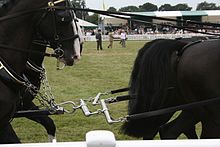Terret


A terret is a metal loop on horse harness, guiding the lines and preventing them from becoming tangled or snagged on the harness.
The lines run from the hands of the driver, through the terrets, and then attach to the horse's bit to guide the horse. Most harness has two pairs of terrets, one on the harness saddle, and one on the hames of the collar (or on the neck-strap of a breast collar). Terrets are commonly made of brass or steel, and they may stand up stiffly, or they may consist of a hinged ring. They are usually circular, but may be U-shaped or square.
Where a horse is driven behind another (such as in a team of four or more, or in tandem), each terret on the rear animal's harness may be divided into two, allowing the lines for the forward and rear animals to be kept separate. There may also be an additional pair of head terrets on the rear animal's bridle, taking the reins for the forward animal.
The word terret may also be used for other metal loops for attaching ropes or chains, such as the ring on a dog collar. The word derives from the Old French toret or touret, meaning small and round.[1]
Bronze terrets from horse harness are a common archaeological find from the European Iron Age, sometimes with decoration.
References
- ^ Oxford English Dictionary 1933: headword "Terret"
See also
